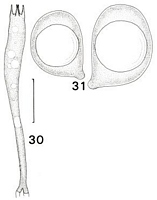|
 Clavaria redoleoalii Clavaria redoleoalii
BiostatusPresent in region - Indigenous. Endemic
Images (click to enlarge)
Caption: Figs 30-31. Clavaria redoleo-alii. 30, basidium (not to scale). 31, spores. TENN no. 42443. | 
Caption: Microfiche 1-23. Clavaria redoleo-alii. TENN no. 43599. | 
Caption: 1532, id. R. Petersen, label 50x10mm, cf. 1520 C. junquillea, NZ, NI, Urewera N.P., on soil under Nothofagus sp., 31.05.1981, leg. EH
Owner: E. Horak |
Article: Petersen, R.H. (1988). The clavarioid fungi of New Zealand. New Zealand Department of Scientific and Industrial Research, Bulletin 236: 170 pp. Wellington:.
Description: Fruit bodies up to 70 x 3 mm, simple clubs, scattered to gregarious, not cespitose, and
narrowly fusiform to narrowly cylindrical. Club white, ivory or pallid yellow ("cartridge-yellow"), occasionally grey when mature
("smoke-grey", TENN no. 42443), opaque,appearing waxy; apex narrowly rounded, yellowish ("chamois", "honey-yellow"). Stipe equal
to tapering slightly downward, white at all ages, arising from small white mycelial patch,
silky-striate. Odour and taste weakly to strongly of garlic.
Macrochemical reaction: FCL = negative.
Tramal hyphae inflated, clampless, thin-walled, adherent, strictly parallel; secondary septa
common. Subhymenium well developed, pseudoparenchymatous. Basidia (Fig. 30) 35-50 x
7-10 µm, clavate, clamped, contents homogeneous to sparsely multiguttulate at maturity, but
not highly refringent; guttules liberated in squash mounts; sterigmata 4, stout.
Spores (Fig.31) 7.6-9.4 x 6.1-6.8 µm (E = 1.17-1.44; Em = 1.28; Lm = 8.56 µm), subglobose
to very broadly ovate, smooth, thin-walled; contents uniguttulate at maturity, the guttule
highly refringent; hilar appendix prominent, papillate.
Habitat: On soil and humus under mixed Nothofagus and podocarp forests.
Notes: Other Clavaria taxa with a strong garlic or onion odour include C. alliacea Corner, and C.
alliodora Bond. & Singer. The first (q.v.) has been assumed to be a member of subg. Clavaria (no basidial clamp), and the
second cannot now be placed.
Perhaps the taxon sharing the highest number of correlated characters with C. redoleo-alii is
C. acuta. which has been reported from almost all parts of the world. Indeed, the two may be
indistinguishable in the field, and even under the microscope except by their spore statistics
which differ somewhat. At the same time, most herbarium specimens (in general as well as
specific) do not include data on taste and odour. From fresh material gathered in Europe and
North America, it seems that fruit bodies of C. acuta do not produce a discernible odour.
Conversely, the odour of fruit bodies of C. redoleo-alii is often so strong as to slowly fill a
room from a few fruit bodies. In the fresh state, therefore, the two are unmistakable, and
even overlap in range (C. acuta has been reported from southeastern Australia and Tierra del
Fuego, as well as New Zealand). Preserved material will be difficult to identify in the future
without notes on odour.
I have been tempted, of course, to propose this taxon as a variety of Clavaria acuta, for the
differences between them seem minor. To do so, however, would be to draw a phylogenetic
conclusion that the two belong to some restricted gene pool at the conspecific (indeed
consubspecific) level. I do not wish to draw such a conclusion or to indicate its probability,
so the taxon is proposed as co-equal with C. acuta.
Proposal of a new taxon in Clavaria when C. alliacea Corner (1950; p. 224) is available in
the literature will be questioned. Two reasons can be offered, one taxonomic, the other
nomenclatural. Firstly, as reported by Corner (1950; 1967, p. 33; 1970), C. alliacea produces
only 1-2-sterigmatebasidia, distinguishing it from either of the new garlic-smelling taxa
proposed here. Secondly, no type specimen has been declared in all these reports, so the
ultimate identification of Corner's taxon cannot be made. Reid (1963) reported on material
from New Zealand.
Although the colour of New Zealand specimens cannot be stated (cf. Reid 1963), but
presumably might be white, the odour of garlic easily separates C. alliacea from the only
other 2-sterigmate species of subg. Holocoryne reported here. Neither author reported on
basidial bases, however, so C. may be in subg. Clavaria.
Likewise, it must be pointed out that C. alliodora Bondartsev & Singer was described from fruit bodies from a greenhouse, is
4-sterigmate, with appropriate spores. It is important to
give it a subgeneric placement at this time, but to use the name promiscuously would not
bring attention to the New Zealand taxon described here. Eventually a prior name may replace the epithet used here.
|